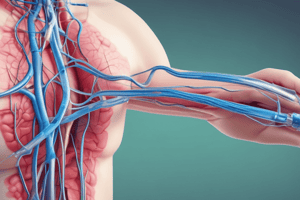Podcast
Questions and Answers
What is the purpose of an intravenous drip?
What is the purpose of an intravenous drip?
- To deliver oxygen to the bloodstream
- To drain fluid from the body
- To administer medication through an IV access device (correct)
- To remove electrolyte imbalances
Which type of fluid is a commonly used crystalloid for intravenous drip?
Which type of fluid is a commonly used crystalloid for intravenous drip?
- Gelatin
- Plasma
- Sodium chloride 0.9% (correct)
- Blood
What is the purpose of using a tourniquet in peripheral intravenous cannulation?
What is the purpose of using a tourniquet in peripheral intravenous cannulation?
- To make veins more visible and easier to puncture (correct)
- To flush the cannula with normal saline
- To sterilize the area for cannulation
- To administer medication through the cannula
Which type of intravenous cannula is flexible and contains a trocar at one end?
Which type of intravenous cannula is flexible and contains a trocar at one end?
What should be done after observing flashback of blood in the cannula during peripheral intravenous cannulation?
What should be done after observing flashback of blood in the cannula during peripheral intravenous cannulation?
When should the tourniquet be released during peripheral intravenous cannulation?
When should the tourniquet be released during peripheral intravenous cannulation?
What should be done after withdrawing the needle slightly during peripheral intravenous cannulation?
What should be done after withdrawing the needle slightly during peripheral intravenous cannulation?
What should be done after securing the catheter with tape during peripheral intravenous cannulation?
What should be done after securing the catheter with tape during peripheral intravenous cannulation?
What is the purpose of the rubber tube in the infusion set?
What is the purpose of the rubber tube in the infusion set?
Which part of the infusion set is responsible for filtering the solution?
Which part of the infusion set is responsible for filtering the solution?
What is the correct procedure to be performed in the medication preparation area?
What is the correct procedure to be performed in the medication preparation area?
What should be done at the patient's bedside during intravenous cannulation?
What should be done at the patient's bedside during intravenous cannulation?
What are crystalloids in the context of intravenous solutions?
What are crystalloids in the context of intravenous solutions?
Which solution is often used for large volume fluid replacement in intravenous drips?
Which solution is often used for large volume fluid replacement in intravenous drips?
What is the main difference between crystalloids and colloids in intravenous solutions?
What is the main difference between crystalloids and colloids in intravenous solutions?
When would a solution of 5% dextrose in water (D5W) be used in intravenous drips?
When would a solution of 5% dextrose in water (D5W) be used in intravenous drips?
Study Notes
Intravenous Drip
- The purpose of an intravenous drip is to administer fluids and medications directly into a vein.
Fluids Used in Intravenous Drip
- Commonly used crystalloid fluids include isotonic solutions like normal saline (0.9% sodium chloride) and lactated Ringer's solution.
- Crystalloids are solutions that contain dissolved crystalline substances, like salts and sugars.
- Crystalloids are often used for large volume fluid replacement in intravenous drips.
Intravenous Cannulation
- A tourniquet is used in peripheral intravenous cannulation to occlude the vein and make it more prominent for cannulation.
- A tourniquet should be released during peripheral intravenous cannulation after the cannula is advanced into the vein.
- A flexible intravenous cannula that contains a trocar at one end is called a scalp vein set.
- After observing flashback of blood in the cannula during peripheral intravenous cannulation, the cannula should be advanced further into the vein.
Securing the Cannula and Infusion Set
- After withdrawing the needle slightly during peripheral intravenous cannulation, the cannula should be advanced further into the vein.
- After securing the catheter with tape during peripheral intravenous cannulation, the tourniquet should be released.
Infusion Set
- The rubber tube in the infusion set connects the IV bag to the cannula and allows for the flow of fluids.
- The filter in the infusion set is responsible for filtering the solution to remove any particles or contaminants.
Medication Preparation and Administration
- In the medication preparation area, the IV solution should be prepared according to the prescribed medication order.
- At the patient's bedside during intravenous cannulation, the cannula should be inserted into the vein and secured in place.
Comparison of Crystalloids and Colloids
- The main difference between crystalloids and colloids in intravenous solutions is the molecular weight of the dissolved substances.
- A solution of 5% dextrose in water (D5W) would be used in intravenous drips to provide hydration and electrolyte-free fluid replacement.
Studying That Suits You
Use AI to generate personalized quizzes and flashcards to suit your learning preferences.
Description
This quiz covers the definition and use of peripheral intravenous cannulation, including the purpose of a cannula and the administration of intravenous drips for fluid infusion, medication delivery, or blood transfusion.




